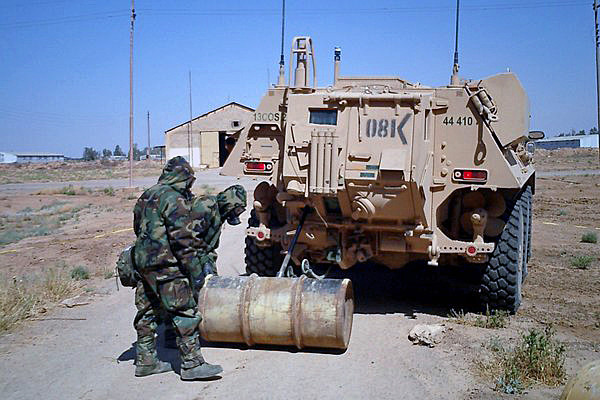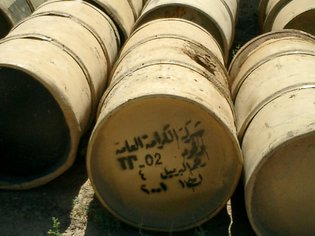PBS: Escaping Eritrea … [Read More...] about ካብ ውሽጢ ቤት ማእሰርታት ኤርትራ
12 Years Later, a Mystery of Chemical Exposure in Iraq Clears Slightly
The toxic vapors acted quickly against the Second Platoon of the 811th Ordnance Company, whose soldiers were moving abandoned barrels out of an Iraqi Republican Guard warehouse in 2003. The building, one soldier said, was littered with dead birds. As the soldiers pushed the barrels over and began rolling them, some of the contents leaked, they said, filling the air with a bitter, penetrating smell. Soon, many were dizzy and suffering from running noses and eyes. A few were vomiting, disoriented, tingling or numb.

After the soldiers staggered outside for air, multiple detection tests indicated the presence of nerve agent. Others suggested blister agent, too. The results seemed to confirm the victims’ fear that they had stumbled upon unused stocks of Iraq’s chemical weapons. From Camp Taji, where the barrels had been found, more than 20 exposed troops were evacuated in helicopters to a military hospital in Balad, where they were met by soldiers wearing gas masks and ordered to undress before being allowed inside for medical care.
“They drew a box in the sand and had armed guards and were like: ‘Do not get out of that box. Do not get out of that box,’ ” said Nathan Willie, a private first class at the time. “I was kind of freaked out.” Since last fall, the United States military has acknowledged that American soldiers found thousands of abandoned chemical weapons in Iraq, and that hundreds of troops notified the military medical system that they believed they had been exposed to them. The military acknowledged the exposures after years of secrecy — and of denying medical tracking and official recognition to victims — only after an investigation by The New York Times.
Even then, the affliction of the 811th Ordnance Company had quietly remained one of the unsolved mysteries of the Iraq war, and a parable of what several of the victims describe as the corrosive effects of the government’s secrecy on troop welfare and public trust. Since the incident, several of the sickened soldiers have complained of health effects that they say may be linked to handling leaking barrels. But instead of finding the Army concerned or committed to their well-being, they faced years of shifting stories about what exactly had made them ill.
The Army, they said, at first suggested that they might have been exposed to the nerve agent sarin. Then it said that chemical warfare field detection tests were unreliable and that the liquid was most likely a pesticide or something else. Then it dropped the subject entirely. Still, several of the victims suffered. But because the military’s records relating to the incident were classified, the victims said, they lacked the information to settle their gnawing worries or to give them the standing necessary to pursue medical care or disability claims.
Thomas S. Blanton, director of the National Security Archive, which advocates open government, said the government’s refusal to share its information was a case of the habits of secrecy trumping common sense. “Soldiers exposed to something really dangerous cannot find out what it was because ‘Sorry it’s classified’?” he said. “It’s creepy and it’s crazy.” “The outrage here,” he added, “is extraordinary.”
Nonetheless, the efforts to ferret out the truth, the victims said, repeatedly met with official indifference, stalled public-records requests and medical care providers who turned them away — belying the Army’s slogan that its soldiers come first. “We were expendable at all costs,” said Kareem Sinclair, who was a specialist in 2003 but is now out of the Army. “It was just fallen by the wayside, kind of like the Vietnam vets with Agent Orange.”
Mr. Sinclair, who complains of headaches and short-term memory loss, said he also wondered whether a cancer of his diagnosed in 2004 was related to the contents of the barrels. Earlier this year, the Pentagon adopted guidelines for screening hundreds of veterans who were exposed to chemical weapons in Iraq. Among those to be offered medical examinations are roughly two dozen soldiers from the 811th Ordnance Company and others who worked with or treated them after their exposure in 2003, according to Brad R. Carson, an acting under secretary of defense, who led the Pentagon’s review of chemical casualties.

And last week, after repeated requests by The Times, the Army declassified a two-page document that appears to answer the veterans’ first question: What was in the barrels? The document, a site survey report written after liquid samples were tested by the Iraq Survey Group, the task force organized by the Pentagon and the Central Intelligence Agency to examine Iraq’s special weapons programs, identified the contents as benzenamine 3,4 dimethyl, an organic compound with multiple industrial uses.
In boldface letters, the report called the compound “a carcinogen and poisonous chemical.” Chemists and chemical warfare specialists interviewed said the chemical was part of a family of organic compounds used in a binary rocket fuel for Eastern bloc missiles and rockets, including variants of the Scud. The fuel, sometimes called TG-02 or Tonka fuel, is known to cause acute exposure symptoms that partly mirror those for nerve agents, including intense headaches, confusion, weakness, depression of the central nervous system and death.
When asked why the Army had not shared its information for more than a decade, Mr. Carson said he was at a loss, beyond the fact that the Iraq Survey Group was not in the Army’s chain of command, which may have limited the information flow. “All I can do is level with them with now,” Mr. Carson said of the veterans. One of them, former Sgt. First Class Dennis Marcello, had been fighting for the records since 2009, when he first filed a Freedom of Information Act request for the documents related to the soldiers’ exposure. He expressed gratitude at the belated release, but also anger and a sense of vindication after having been what he called “slow-rolled” for years.
“The government knew beyond doubt that it was toxic and failed to inform and properly treat the troops, and kept that information from them for a decade-plus,” Mr. Marcello said. “There is no denying this now.” For many of the victims, the government’s long reluctance to share its records has been one part of an operation mishandled from the outset. After the defeat of Iraq, as American forces began the long occupation of the country, the 811th Ordnance Company, a reserve unit with soldiers from West Virginia and Virginia, was assigned to secure stockpiles of abandoned Iraqi ordnance.
Lt. Col. Timothy Cary, who commanded the company as a captain in 2003, said his soldiers were ordered to sort and store as much as 50 convoys of captured ammunition each day — a task for which they were neither equipped nor prepared. “The way they formed this task force to deal with this stuff was uncalled-for,” On May 13, 2003, the company was assigned to clear a warehouse formerly used by the Republican Guard’s rocket and missile corps. Inside were about two dozen barrels.
The soldiers were not provided a translator to help them read the labels or any warnings on the building’s doors and walls. They were not carrying gas masks. As the work began, Pfc. Jessica Snyder felt a flash of concern. “When we went in, before we started rolling stuff out, there were dead birds lying around,” she said. While the soldiers were moving the barrels, a strong pungent odor rose. Mr. Sinclair said the smell was slightly sweet, and its effects were swift.
“As soon as it made contact with my mouth and nose, my eyes started to water and my nose started running and then I started throwing up,” he said. “It happened really fast, and it was like a chain reaction” as others fell ill, he said. The company’s young officers quickly arranged for the soldiers to be moved to a clinic, where their arrival “set off an alarm on the whole base,” said Maj. Marcus Clonch, who was a first lieutenant and the company’s executive officer at the time.

After the troops were flown to Balad, they were admitted to the hospital for stays of up to a few days, before returning to duty at Taji. Field detection tests indicated the presence of nerve agent at the warehouses, though the victims and chemical warfare specialists alike noted that the field tests are prone to false positives, and are not considered conclusive. In the climate of uncertainty, several of the victims said, they were ordered not to discuss their exposure, and the Army did little to answer questions about what had occurred.
“They told us we weren’t supposed to talk to reporters or anyone when we came back,” said Ray Sirbaugh, a specialist at the time who is now medically retired from other wounds. He said he had suffered headaches and memory loss since inhaling the vapors. Mr. Willie confirmed Mr. Sirbaugh’s account. “I remember Ray and Sinclair, they were older than us, and they wanted to get some answers, and they came back and said they were told not to talk about it,” Mr. Willie said. “It was a big morale killer.”
Ms. Snyder, who was honorably discharged from the Army in 2010 as a sergeant, said the Army never discussed any risks associated with the exposure. “I heard it was pesticide, I heard it was full-blown nerve agent,” she said. “They didn’t give us enough information about it, and it would have been nice to have been tested over the years in case something is wrong.” Several soldiers said one young officer acting on his own — Lieutenant Clonch, now a major — created an unclassified record that eventually allowed the veterans to confront the Army.
The record, a memo summarizing what happened at the warehouse, did not declare what the soldiers had inhaled; Major Clonch said in an interview that he was never able to find out. But he made a point of sharing his memo, which noted the positive field test results for nerve agent, with the rank and file. “The account I did was for everybody’s medical record,” he said. “That was really the only record we were given.” The record did not spur the Army to disclose what it knew, or to examine the victims for long-term health problems. Several victims said it did not even make its way into their records. But they retained personal copies, which ultimately provided a means for one of the exposed veterans, Mr. Marcello, to try years later to have the incident recognized.
Mr. Marcello said he used photographs from the warehouse and the lieutenant’s memo as part of the public-records request he first filed in 2009, seeking to force the Army to reveal the details. Mr. Carson, after reviewing Mr. Marcello’s long-idle records requests at the request of The Times, approved the release of the two-page report last week. Mr. Marcello received a copy of the record Tuesday afternoon.
But the Army has still not released many other records he sought, or provided answers to his lingering questions, including what ultimately happened to the barrels. The Iraq Survey Group did not extract liquid samples from the barrels until August 2003, roughly three months after the soldiers were exposed. Later, Mr. Marcello said, he returned to the warehouse to check on the barrels. They were gone.
“Where did those barrels finally go?” he asked. “Who took them? How were they disposed of? You ask yourself these questions, year after year, and you wonder: Why is all of this some kind of secret operation?”
